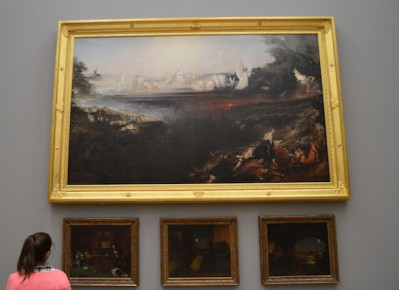LONDON, U.K. Within the recently re-organised Tate Britain Walk through British Art hangs three paintings by the apocalyptic artist John Martin. Standing, gazing up at these images of biblical destruction, one can’t help but feel overwhelmed by the pure epicness of size. The paintings hang high. High enough for the bottom comes to just above the average eye height. This forces toe audience to stand back to engage with the image. It also inspires a feeling of awe as you are almost forced to stand back to give the image its own rightful space.
It is the sheer scale of a painting that can evoke the feeling within the viewer that they are standing in the midst of something great and almost powerful.
Rothko’s large paintings displaying shades of colour are known for holding an emotional effect over its audience. This can be seen with in his later paintings, perhaps more so than others. In 1968 Rothko was diagnosed with an aortic aneurysm. Two years later he would take his own life. His later paintings were produced during a period of depression where the artist would drink and smoke heavily against medical advice. His later paintings, large squares of dark blues, blacks and greys, have given their audience overwhelming feelings of sadness and on rare occasions leaving them in tears.
I myself have experienced this in front of these powerful pieces of art. I also experienced a similar reaction to paintings whilst standing in the Peggy Guggenheim collection in Venice. The paintings, produced by Jackson Pollock overwhelmed me with raw emotion. I cannot say whether this emotion could have been labelled or pin pointed, however it was there and it was powerful. Pollock’s paintings have become mass produced images within books, prints and postcards. These smaller copies show the image itself, but they don’t often capture the emotions and awethat comes with standing in the shadow of the real things.
In the 2000 biographic film Pollock, Jackson Pollock (portrayed by Ed Harris, who also directed) is seen to be knocking down walls in his New York apartment so that he is able to construct a monster of a canvas which appears daunting to the painter. Harris’ portrayal of the abstract painter examines the beginning of the painting Mural 1943. Pollock can be seen to be sitting, staring at this huge blank canvas as it occupies a large portion of the apartment. As his wife Lee Krasner (portrayed by Marcia Gay Harden) explains “What do you see there Pollock? You’ve been looking at it for weeks.” More time is shown to have past when the painters eyes open and he suddenly jumps to life painting in a frenzied montage of fluid hand gestures and paint. Of course for the film some artistic licence is used, especially when it comes to moments of inspiration such as this. However, the scene doesn’t shy away from the fact that these large paintings can have an effect on the audience and even the artist before paint has even touched the canvas.
Speaking as a painter myself, I am often confronted with this feeling of intimidation when working on a large scale. I would not say that bravery is needed to tackle such a project. But it takes that little spark of something to place the first marks that become part of something bigger and awe-inspiring. Because that, to me, is part of why I want to create and see large paintings. Not to intimidate and attempt to appear superior, but to inspire and be inspired.

